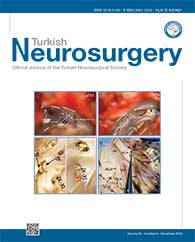2University of Ulsan College of Medicine, Asan Medical Center, Department of Neurosurgery, Seoul, South Korea
3Catholic Kwandong University, College of Medicine, Department of Physiology, Gangneung-si, Gangwon-do, South Korea
4University of Ulsan College of Medicine, Gangneung Asan Hospital, Department of Emergency Medicine, Gangneung, South Korea
5Korea University Medicine, Department of Neurosurgery, Seoul, South Korea DOI : 10.5137/1019-5149.JTN.41249-22.2 AIM: To compare, and to analyze the clinical and radiological signs between bidirectional and unidirectional screw fixation in single level cervical discectomy and fusion surgery.
MATERIAL and METHODS: We retrospectively reviewed the data collected from 90 patients and divided them into the upper or lower spine fixation group (unidirectional) and the normal upper and lower spine fixation group (bidirectional). The patients? demographic data and preoperative and postoperative (24 months) clinical outcomes were collected. Pre- and postoperative (immediately and at 3, 6, 12, and 24 months) changes in the segmental angle in the operating field (SA), cervical lordosis, C2?7 sagittal vertical axis, and active disc height (aDH) were evaluated. We also compared the rate of fusion and muscle size change between the groups.
RESULTS: The operation time in the bidirectional screw fixation group was significantly longer than that in the unidirectional screw fixation group (>6 min; p=0.03). There was no significant difference between the two groups in radiographic parameters before and immediately after surgery. From 3 months postoperatively, the unidirectional group had significantly higher SA and aDH than the bidirectional group (p=0.03). The fusion rate was higher in the bidirectional screw fixation group than in the unidirectional group, but this was not statistically significant (97% vs. 88%, p=0.07).
CONCLUSION: The results of this study suggest that unidirectional screw fixation surgery can be useful as it has been associated with simple surgery, short surgery time, and maintenance of the lordotic curvature of SA and disc height.
Keywords : Cervical spine, Screw direction, Spinal curvatures, Spinal fusion, Discectomy




